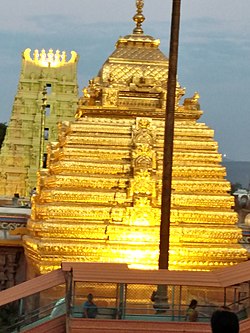Among the fifty-one revered Shakti Peethas spread across the Indian subcontinent, Shriparvata in Andhra Pradesh holds a place of deep spiritual significance. It is believed to be the spot where the right foot of Goddess Sati fell when Lord Vishnu dismembered her body to calm Lord Shiva’s grief. This sacred site is dedicated to Goddess Sundari (a form of Shakti) and Lord Shiva, who is worshipped here as Sundarananda.
The presence of the goddess’s foot makes Shriparvata not just a geographical location but a living symbol of divine energy, drawing countless devotees every year who seek blessings of strength, peace, and fulfillment.

Historical and Mythological Background
The story of Shriparvata, like other Shakti Peethas, is rooted in the legend of Sati and Shiva. According to ancient texts:
- When Goddess Sati immolated herself in Daksha’s Yajna, Lord Shiva was overcome with sorrow and rage.
- Carrying her lifeless body, he wandered across the cosmos, shaking the universe with his grief.
- To pacify him and restore cosmic balance, Lord Vishnu used his Sudarshana Chakra to cut Sati’s body into pieces.
- Each place where a part of her body fell became a Shakti Peeth.
- At Shriparvata, it is said that her right foot touched the ground, sanctifying the hill with divine presence.
This mythological narrative not only explains the temple’s sacredness but also weaves Shriparvata into the larger fabric of Sanatana Dharma and its deeply symbolic geography.
Location and Setting
Shriparvata is located in Andhra Pradesh, near Srisailam, a town famous for its association with Lord Mallikarjuna, one of the twelve Jyotirlingas. The Shakti Peeth lies amidst the scenic hills of the Nallamala Range, part of the Eastern Ghats.
- The temple complex is surrounded by dense forests, rivers, and hill slopes, making it not just a spiritual destination but also a place of natural beauty.
- The Krishna River, which flows nearby, adds to the sanctity of the site. Devotees often take a holy dip before entering the shrine.
- The serene and somewhat isolated setting makes Shriparvata ideal for meditation and spiritual practices.
The combination of Shakti Peeth and Jyotirlinga in close proximity makes this region one of the most powerful centers of Hindu pilgrimage in South India.
Deity and Worship
At Shriparvata, the presiding deity is Goddess Sundari, representing the graceful and nurturing aspect of Maa Shakti. Her presence here as the fallen right foot emphasizes the divine connection to strength, foundation, and balance.
Alongside her, Lord Shiva is worshipped as Sundarananda, symbolizing the eternal union of Shakti and Shiva.
- Idol Representation: The goddess is depicted in a simple yet powerful form, radiating grace and protective energy.
- Daily Worship: Pujas include chanting of Shakti mantras, offering flowers, coconuts, and traditional lamps.
- Special Beliefs: It is said that those who worship here with devotion gain courage, harmony in family life, and spiritual progress.
Importance of the Right Foot of Sati
The right foot carries special symbolic meaning in Hindu tradition:
- It signifies stability and progress in both spiritual and worldly life.
- Worship at Shriparvata is believed to remove obstacles and bless devotees with a steady path in their endeavors.
- The right foot is also associated with dharma (righteousness) and balance, reinforcing the temple’s role as a guide for moral and spiritual living.
Thus, Shriparvata Shakti Peeth becomes more than a temple – it is seen as a foundation of spiritual energy.
Festivals and Celebrations
Several festivals are celebrated at Shriparvata with devotion and enthusiasm:
- Navratri:
- The nine nights dedicated to the goddess are the most important here.
- Devotees observe fasting, perform special pujas, and participate in cultural programs like devotional singing and dance.
- The temple is adorned with lamps and flowers, creating an atmosphere of divinity.
- Shivratri:
- Since the temple also honors Lord Shiva, Shivratri is celebrated with equal reverence.
- Night-long vigils, chanting of Shiva mantras, and rituals strengthen the spiritual connection between Shakti and Shiva.
- Local Fairs and Annual Temple Festival:
- The local communities organize fairs during temple festivals where devotees gather, reinforcing cultural and social bonds.
These festivals make Shriparvata not only a place of individual devotion but also a hub of community worship.
Pilgrimage Experience
A journey to Shriparvata is both spiritual and rejuvenating:
- Approach: Pilgrims usually reach Srisailam and then proceed towards Shriparvata. The route passes through winding forested paths and hilly terrain.
- Sacred Dip: Before entering the temple, many devotees bathe in the Krishna River, considering it a purifier of body and mind.
- Temple Visit: The darshan of Goddess Sundari is described as calming and empowering, giving devotees a sense of fulfillment.
- Meditation and Silence: The surrounding hills make the place ideal for seekers who wish to meditate or reflect in silence.
The pilgrimage is considered complete when devotees also visit the Mallikarjuna Jyotirlinga, making it a holistic experience of both Shiva and Shakti.
Spiritual Significance
The energy of Shriparvata is believed to resonate strongly with those seeking stability, strength, and inner clarity. Pilgrims often share experiences of feeling lighter, peaceful, and more grounded after worshipping here.
- For Families: Blessings for harmony and fertility.
- For Devotees: Strength to overcome obstacles in spiritual practice.
- For Seekers: A place to balance material life with spiritual growth.
Shriparvata thus continues to be a living source of divine guidance for devotees across generations.
FAQs for Shriparvata (Mallikarjuna) Temple
1. Why is Shriparvata Temple famous?
Shriparvata (Mallikarjuna) Temple is a revered Shakti Peetha and one of the 12 Jyotirlingas, dedicated to Lord Shiva and Goddess Shakti.
2. Where is Shriparvata Temple located?
It is located in Srisailam, Nallamala Hills, Andhra Pradesh, surrounded by scenic forests and hills.
3. What is worshipped at Shriparvata Temple?
The temple worships Lord Shiva (Mallikarjuna) and Goddess Bhramaramba (Shakti), representing divine masculine and feminine energies.
4. What are the temple timings?
The temple opens from 6:00 AM to 1:00 PM and 3:00 PM to 8:00 PM, with special rituals during festivals.
5. Is photography allowed inside Shriparvata Temple?
Photography is not allowed inside the sanctum, but permitted in the temple premises and surrounding areas.
6. What is the significance of Shriparvata as a Shakti Peetha?
It is believed that the genitals of Goddess Sati fell here, making it a sacred site of spiritual energy and worship.
7. How can I reach Shriparvata Temple?
Accessible via road from Hyderabad or Kurnool, and nearest railway station is Srisailam Road. Buses and taxis connect pilgrims to the temple.
8. Are there any special rituals at Shriparvata Temple?
Yes, daily aarti, abhishekam, and special pujas are performed. Bhramaramba Navaratri is a major festival here.
9. Is there accommodation near Shriparvata Temple?
Yes, Srisailam offers guesthouses, ashrams, and hotels for pilgrims and tourists.
10. What is the best time to visit Shriparvata Temple?
October to March is ideal, especially during Navaratri when devotees gather in large numbers.


